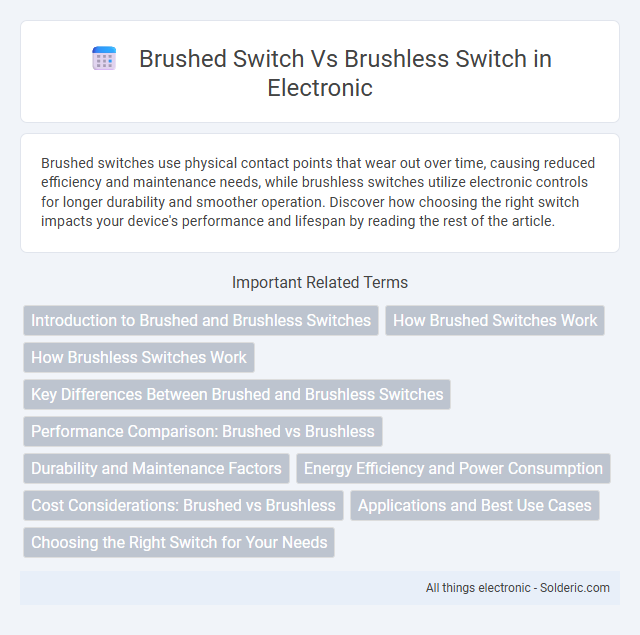Brushed switches use physical contact points that wear out over time, causing reduced efficiency and maintenance needs, while brushless switches utilize electronic controls for longer durability and smoother operation. Discover how choosing the right switch impacts your device's performance and lifespan by reading the rest of the article.
Comparison Table
| Feature | Brushed Switch | Brushless Switch |
|---|---|---|
| Mechanism | Uses brushes to conduct current | No brushes; uses electronic commutation |
| Durability | Lower; brushes wear over time | Higher; no brush wear |
| Maintenance | Requires regular brush replacement | Low maintenance; fewer parts to wear |
| Efficiency | Less efficient due to friction | More efficient; reduced energy loss |
| Cost | Lower initial cost | Higher initial cost |
| Noise | Noisier due to brush friction | Quieter operation |
| Applications | Basic electrical switches, low-cost devices | High-performance electronics, precision devices |
Introduction to Brushed and Brushless Switches
Brushed switches rely on physical brushes to conduct electricity, making them simpler and cost-effective for basic applications. Brushless switches utilize electronic commutation, offering higher efficiency, longer lifespan, and reduced maintenance due to the absence of mechanical brushes. These distinctions significantly impact performance in motors, power tools, and various electronic devices.
How Brushed Switches Work
Brushed switches operate using mechanical contacts that physically touch to complete an electrical circuit, causing a current flow. The internal brushes slide over conductive surfaces, creating friction and wear over time, which can reduce their lifespan. Understanding how brushed switches function helps you determine their suitability for applications requiring reliable, yet cost-effective, mechanical switching.
How Brushless Switches Work
Brushless switches operate using electronic circuits that control the motor's power without physical brushes, reducing friction and wear. They rely on sensors to detect rotor position and adjust current flow accordingly, ensuring smooth and efficient performance. This technology enhances reliability, extends lifespan, and minimizes maintenance compared to brushed switches.
Key Differences Between Brushed and Brushless Switches
Brushed switches utilize physical brushes to conduct electricity and engage mechanical contacts, resulting in wear and limited lifespan, while brushless switches rely on electronic sensors and solid-state components for contactless operation, enhancing durability and efficiency. The key differences include mechanical wear in brushed switches versus the almost maintenance-free nature of brushless switches, as well as noise levels, with brushed switches generating audible contact noise and brushless switches operating silently. Brushless switches often support faster switching speeds and improved reliability, making them suitable for applications requiring high precision and low electromagnetic interference.
Performance Comparison: Brushed vs Brushless
Brushless switches provide superior performance over brushed switches by delivering higher efficiency, longer lifespan, and reduced maintenance due to the absence of physical brushes causing wear and friction. Brushed switches typically experience voltage drops and heat generation from brush contact, which limits their speed and durability. For your applications requiring reliable operation and consistent power output, brushless switches offer enhanced precision and smoother control.
Durability and Maintenance Factors
Brushed switches require frequent maintenance due to brush wear and potential carbon buildup, reducing overall durability. Brushless switches offer enhanced longevity as they eliminate brush contact, resulting in less friction and fewer mechanical failures. Choosing a brushless switch can significantly improve your system's reliability and decrease maintenance costs over time.
Energy Efficiency and Power Consumption
Brushless switches exhibit higher energy efficiency compared to brushed switches due to the elimination of friction and electrical losses from brushes, resulting in lower power consumption during operation. Brushed switches experience energy loss via brush friction and sparking, leading to reduced overall efficiency and increased maintenance requirements. Consequently, brushless technology is preferred in applications prioritizing sustainable power management and prolonged device lifespan.
Cost Considerations: Brushed vs Brushless
Brushed switches typically cost less due to simpler design and lower manufacturing expenses, making them a budget-friendly option for basic applications. Brushless switches, while more expensive upfront, offer longer lifespan and reduced maintenance costs, providing better value over time. Your choice between brushed and brushless should factor in initial cost versus long-term savings and performance needs.
Applications and Best Use Cases
Brushed switches are ideal for low-cost, simple applications such as basic household appliances, toys, and entry-level power tools where maintenance is minimal and initial cost is a priority. Brushless switches excel in high-performance scenarios including electric vehicles, industrial automation, and robotic systems, offering superior durability, efficiency, and reduced electromagnetic interference. Choosing between brushed and brushless switches depends on application-specific factors like power requirements, lifespan, and operational environment.
Choosing the Right Switch for Your Needs
Choosing the right switch depends on the application requirements and maintenance preferences. Brushed switches are typically more affordable and offer straightforward control but require regular maintenance due to brush wear. Brushless switches provide higher efficiency, longer lifespan, and reduced noise, making them ideal for precision devices and continuous operation without frequent servicing.
brushed switch vs brushless switch Infographic

 solderic.com
solderic.com